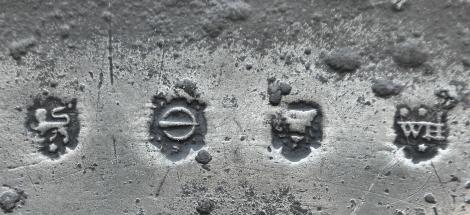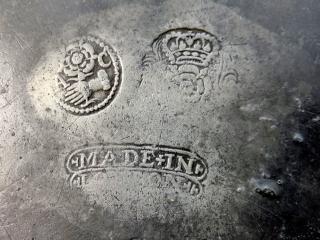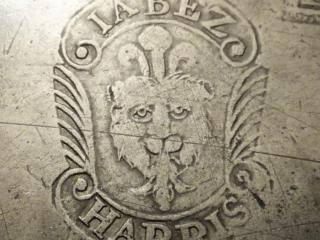Pewterers’ marks

British and Irish pewter is often unmarked. If marks are present, they can help in identifying when and where the item was made or used.
Types of mark
Whereas the marks on silver and gold have always been tightly controlled, there was very little control over the marks used by pewterers. As a result, they vary widely in form and significance. They fall into five broad categories:
- ‘touch marks’, often including the pewterer’s name or initials
- pseudo-hallmarks
- quality marks
- labels
- numbers
Wares often have marks from more than one of these categories, and that can be very helpful. Because pewter is a soft metal, marks can often get very worn, but even if a touch is too worn to identify, you might nevertheless be able to identify the pewterer from other marks that are present.
Identifying the pewterer
There was no central register of pewterers or their marks, so identifying the pewterers and the marks they used is only possible as a result of decades of research, a process that is still ongoing. The Pewter Society database of British & Irish makers and their marks is the most comprehensive source of information. It supersedes all printed publications on the subject, is being constantly updated and it is only available to members. Join the society and carry the database around with you via your mobile phone or tablet when visiting auctions, antiques fairs and antique shops.
If you only have a couple of pieces, the Society is willing to identify the marks for you if we can. This service is free, but it is not available to dealers nor to individuals if the sole purpose of the identification is to facilitate the sale of the item.
See our Help with identification section and recent enquires in that section
Who else used marks?
Whilst pewterers sold wares they had made themselves, they would also sometimes buy stock wholesale from other pewterers to add to the range of wares they could offer for sale. Thus often we cannot be sure whether the pewterer whose marks appear on a piece actually made it or merely sold it. Indeed, sometimes you will find the marks of two different pewterers – the one who made it and the one who sold it.
In the 19th and 20th centuries other businesses such as ironmongers started buying wholesale from pewterers and re-selling under their own name. In these cases the marks don’t belong to a pewterer at all but merely to a retailer.
Unmarked pieces
Many pieces of pewter were never marked. We don’t know why, but the items are normally of perfectly good quality and so there’s no reason to be suspicious of them.

